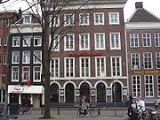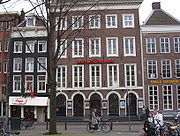
De Kleine Komedie
Encyclopedia

Amsterdam
Amsterdam is the largest city and the capital of the Netherlands. The current position of Amsterdam as capital city of the Kingdom of the Netherlands is governed by the constitution of August 24, 1815 and its successors. Amsterdam has a population of 783,364 within city limits, an urban population...
, dating from 1788. Situated on the Amstel
Amstel
The Amstel is a river in the Netherlands which runs through the city of Amsterdam. The river's name is derived from Aeme stelle, old Dutch for "area abounding with water"....
near the Halvemaansteeg, the building offers a stage
Stage (theatre)
In theatre or performance arts, the stage is a designated space for the performance productions. The stage serves as a space for actors or performers and a focal point for the members of the audience...
for both upcoming and established Dutch talents. The theatre has 503 seats.
History of the building
The first theatre built in Amsterdam was the Schouwburg of Van Campen on Keizersgracht 384 in 1637, which burned down in 1772. That theatre company then moved to the LeidsepleinLeidseplein
The Leidseplein is a square in central Amsterdam, the Netherlands. Lying in the southwest of the Grachtengordel district of Amsterdam, the Leidseplein is immediately northeast of the Singelgracht canal. It is situated on the crossroads of the Weteringschans, the Marnixstraat, and the Leidsestraat...
, where it built a theatre in 1774, the first Stadsschouwburg
Stadsschouwburg (Amsterdam)
The Stadsschouwburg of Amsterdam is the name of a theatre building at the Leidseplein in Amsterdam in the Netherlands. The building is in the neo-Renaissance style dating back to 1894, and is the former home of the National Ballet and Opera.-The Rederijkerskamers:The first rederijkers appeared at...
. That building burned down in 1892 (the present building was built in 1894), making De Kleine Komedie the oldest surviving theatre in Amsterdam.
In 1784 Henry Hope
Henry Hope
Henry Hope was an Amsterdam merchant banker born in Boston, in Britain's Massachusetts Bay Colony in North America.-Early years:...
of Hope & Co.
Hope & Co.
Hope & Co. is the name of a famous Dutch bank that spanned two and a half centuries. Though the founders were Scotsmen, the bank was located in Amsterdam, and at the close of the 18th century it had offices in London as well.-Early days:...
purchased ground on the Amstel near the east side of the Halvemaansteeg in Amsterdam
Amsterdam
Amsterdam is the largest city and the capital of the Netherlands. The current position of Amsterdam as capital city of the Kingdom of the Netherlands is governed by the constitution of August 24, 1815 and its successors. Amsterdam has a population of 783,364 within city limits, an urban population...
, together with his fellow banker friends Balthazar Elias Abbema, Pieter de Smeth, Henry Fizeaux, Jean Alexander Botereau, and Pieter Muilman. They commissioned the building to the architect Abraham van der Hart
Abraham van der Hart
Abraham van der Hart , was an 18th century architect from the Northern Netherlands.-Biography:According to the RKD he learned architecture and draughtsmanship from his father, Jan van der Hart, and became an architect specialized in Neoclassicism, who built the Hodson house and Barnaart house in...
who completed it in 1788. The commissioners were all very influential men of Amsterdam who had far reaching connections. Henry Fizeaux was a banker who had close ties with John Adams
John Adams
John Adams was an American lawyer, statesman, diplomat and political theorist. A leading champion of independence in 1776, he was the second President of the United States...
and Benjamin Franklin
Benjamin Franklin
Dr. Benjamin Franklin was one of the Founding Fathers of the United States. A noted polymath, Franklin was a leading author, printer, political theorist, politician, postmaster, scientist, musician, inventor, satirist, civic activist, statesman, and diplomat...
. He tried to raise funds for the American cause and shared revolutionary
Revolutionary
A revolutionary is a person who either actively participates in, or advocates revolution. Also, when used as an adjective, the term revolutionary refers to something that has a major, sudden impact on society or on some aspect of human endeavor.-Definition:...
sympathies, though merchant
Merchant
A merchant is a businessperson who trades in commodities that were produced by others, in order to earn a profit.Merchants can be one of two types:# A wholesale merchant operates in the chain between producer and retail merchant...
tradition was to deny political preferences. The 'Patriotic' or 'Anti-Orange' sympathies of the directors Henry Fizeaux and Jean Alexander Botereau resulted in their stepping down in 1787 when the House of Orange was re-established. Orangist Henry Hope
Henry Hope
Henry Hope was an Amsterdam merchant banker born in Boston, in Britain's Massachusetts Bay Colony in North America.-Early years:...
took over the running of the establishment until he fled the country before Napoleon's army in 1794.
Théâtre Français
It was called the Théâtre Français sur l'Erwtemarkt in 1784, the year performances began. In those days, the performances were often in French and modelled on a ParisParis
Paris is the capital and largest city in France, situated on the river Seine, in northern France, at the heart of the Île-de-France region...
ian theater form that was very popular. Napoleon himself supported the Théâtre Français, and French opera
Opera
Opera is an art form in which singers and musicians perform a dramatic work combining text and musical score, usually in a theatrical setting. Opera incorporates many of the elements of spoken theatre, such as acting, scenery, and costumes and sometimes includes dance...
's and plays
Play (theatre)
A play is a form of literature written by a playwright, usually consisting of scripted dialogue between characters, intended for theatrical performance rather than just reading. There are rare dramatists, notably George Bernard Shaw, who have had little preference whether their plays were performed...
were shown in the theatre well into the 19th century.
When the interest in French plays decreased, the building was sold to the 'Neues Deutsches Theater' that performed German plays. In 1856 the building came into the hands of the Free Church of Scotland and was rechristened 'Scottish Missionary Church'. The driving force behind the Dutch branch of this church was the Rev. August Ferdinand Carl Schwartz
Carl Schwartz
Dr August Ferdinand Carl Schwartz was a leading Hebrew Christian clergyman and minister of the Free Church of Scotland in Amsterdam, then Free Church minister in London....
(1817–1870), the father of the novelist Maarten Maartens
Maarten Maartens
Maarten Maartens, pen name of Jozua Marius Willem van der Poorten Schwartz , was a Dutch writer, who wrote in English...
.
When the Vrije Universiteit
Vrije Universiteit
The Vrije Universiteit is a university in Amsterdam, Netherlands. The Dutch name is often abbreviated as VU and in English the university uses the name "VU University". The university is located on a compact urban campus in the southern part of Amsterdam in the Buitenveldert district...
(Free University) of Amsterdam started in 1880, it hired some rooms in the Scottish Missionary Church and used them as lecture rooms. Here the founder Abraham Kuyper
Abraham Kuyper
Abraham Kuijper generally known as Abraham Kuyper, was a Dutch politician, journalist, statesman and theologian...
and his four co-professors gave their lectures. In 1883 the Scottish Missionary Church became too small for the quickly growing number of students and the university bought another building.
In the first half of Twentieth Century the building was called Salvatori and was used as a meeting centre. The most various groups met here, from orthodox Protestants to leftist freethinkers. During the Second World War
World War II
World War II, or the Second World War , was a global conflict lasting from 1939 to 1945, involving most of the world's nations—including all of the great powers—eventually forming two opposing military alliances: the Allies and the Axis...
the building was no more than a bicycle shed.
De Kleine Komedie
In 1947 the building was reopened as a theatre, now under its present name 'De Kleine Komedie'. Since then its program is primarily in Dutch. In the Fifties and Sixties many famous people in the Dutch entertainment world, like Toon HermansToon Hermans
Antoine G. T. "Toon" Hermans was a noted Dutch comedian, singer and writer. He was born in Sittard, now part of the municipality of Sittard-Geleen....
, Wim Kan
Wim Kan
Willem Cornelis "Wim" Kan was a Dutch cabaret artist. Together with Toon Hermans and Wim Sonneveld, he is considered to be one of the Great Three of Dutch cabaret....
and Fons Jansen, made appearances in this theatre. In 1973 the building was closed by the Amsterdam fire brigade due to fire hazard. After a renovation financed by private sources, it was reopened in 1978.
In 1988 the continued existence of De Kleine Komedie was put in danger again, when the municipality of Amsterdam wanted to withdraw its subsidy. A campaign launched by the cabaret performer Youp van 't Hek
Youp van 't Hek
Joseph Jacobus Maria "Youp" van 't Hek is a Dutch comedian and a columnist for NRC Handelsblad.- Biography :Youp was born and raised in the Gooi, a wealthy region to the southeast of Amsterdam. His youth there served as an inspiration for his ironic attitude toward the rich, the successful and all...
secured the theatre's subsidy.
Because of its cosy atmosphere De Kleine Komedie is often used for try-out performances by upcoming talents as well as long-established cabaret performers. Many DVD and tv productions are recorded here.
External links
- Official site (site in Dutch)

